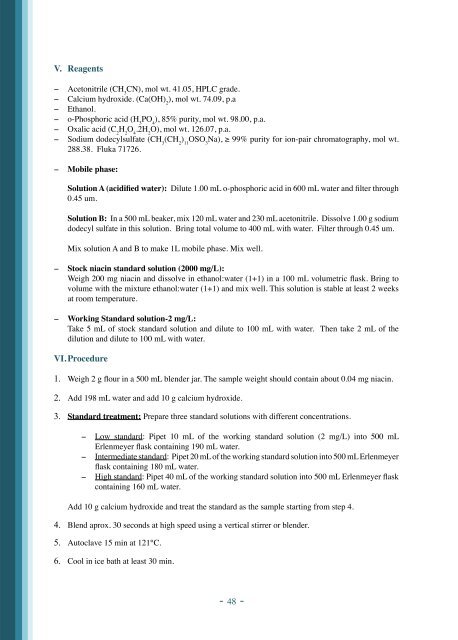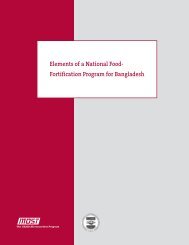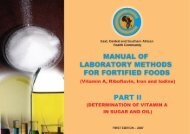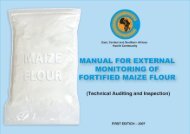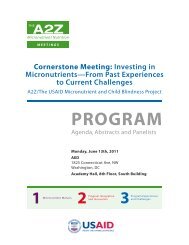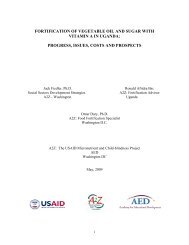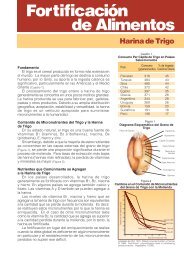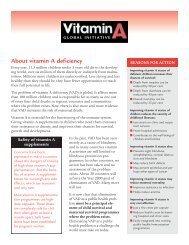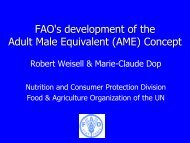manual of methods for determining micronutrients in fortified foods
manual of methods for determining micronutrients in fortified foods
manual of methods for determining micronutrients in fortified foods
You also want an ePaper? Increase the reach of your titles
YUMPU automatically turns print PDFs into web optimized ePapers that Google loves.
V. Reagents<br />
−<br />
−<br />
−<br />
−<br />
−<br />
−<br />
−<br />
Acetonitrile (CH 3<br />
CN), mol wt. 41.05, HPLC grade.<br />
Calcium hydroxide. (Ca(OH) 2<br />
), mol wt. 74.09, p.a<br />
Ethanol.<br />
o-Phosphoric acid (H 3<br />
PO 4<br />
), 85% purity, mol wt. 98.00, p.a.<br />
Oxalic acid (C 2<br />
H 2<br />
O 4<br />
.2H 2<br />
O), mol wt. 126.07, p.a.<br />
Sodium dodecylsulfate (CH 3<br />
(CH 2<br />
) 11<br />
OSO 3<br />
Na), ≥ 99% purity <strong>for</strong> ion-pair chromatography, mol wt.<br />
288.38. Fluka 71726.<br />
Mobile phase:<br />
Solution A (acidified water): Dilute 1.00 mL o-phosphoric acid <strong>in</strong> 600 mL water and filter through<br />
0.45 um.<br />
Solution B: In a 500 mL beaker, mix 120 mL water and 230 mL acetonitrile. Dissolve 1.00 g sodium<br />
dodecyl sulfate <strong>in</strong> this solution. Br<strong>in</strong>g total volume to 400 mL with water. Filter through 0.45 um.<br />
Mix solution A and B to make 1L mobile phase. Mix well.<br />
−<br />
−<br />
Stock niac<strong>in</strong> standard solution (2000 mg/L):<br />
Weigh 200 mg niac<strong>in</strong> and dissolve <strong>in</strong> ethanol:water (1+1) <strong>in</strong> a 100 mL volumetric flask. Br<strong>in</strong>g to<br />
volume with the mixture ethanol:water (1+1) and mix well. This solution is stable at least 2 weeks<br />
at room temperature.<br />
Work<strong>in</strong>g Standard solution-2 mg/L:<br />
Take 5 mL <strong>of</strong> stock standard solution and dilute to 100 mL with water. Then take 2 mL <strong>of</strong> the<br />
dilution and dilute to 100 mL with water.<br />
VI. Procedure<br />
1. Weigh 2 g flour <strong>in</strong> a 500 mL blender jar. The sample weight should conta<strong>in</strong> about 0.04 mg niac<strong>in</strong>.<br />
2. Add 198 mL water and add 10 g calcium hydroxide.<br />
3. Standard treatment: Prepare three standard solutions with different concentrations.<br />
−<br />
−<br />
−<br />
Low standard: Pipet 10 mL <strong>of</strong> the work<strong>in</strong>g standard solution (2 mg/L) <strong>in</strong>to 500 mL<br />
Erlenmeyer flask conta<strong>in</strong><strong>in</strong>g 190 mL water.<br />
Intermediate standard: Pipet 20 mL <strong>of</strong> the work<strong>in</strong>g standard solution <strong>in</strong>to 500 mL Erlenmeyer<br />
flask conta<strong>in</strong><strong>in</strong>g 180 mL water.<br />
High standard: Pipet 40 mL <strong>of</strong> the work<strong>in</strong>g standard solution <strong>in</strong>to 500 mL Erlenmeyer flask<br />
conta<strong>in</strong><strong>in</strong>g 160 mL water.<br />
Add 10 g calcium hydroxide and treat the standard as the sample start<strong>in</strong>g from step 4.<br />
4. Blend aprox. 30 seconds at high speed us<strong>in</strong>g a vertical stirrer or blender.<br />
5. Autoclave 15 m<strong>in</strong> at 121°C.<br />
6. Cool <strong>in</strong> ice bath at least 30 m<strong>in</strong>.<br />
- 48 -


